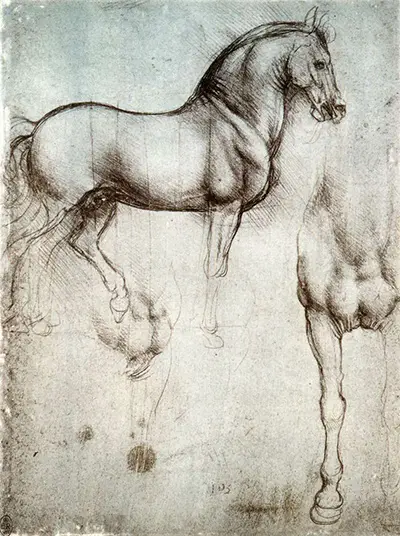In 1482 da Vinci approached the Duke of Milan, Ludovico "Il Moro" Sforza and offered to make a monument in honour of the Duke's father, which would stand guard at the castle. The plan was ambitious and grand.
The statue was to be of a huge horse, ridden by the Duke's father, Francesco Sforza that would require around 80 tons of bronze.
The Duke agreed and commissioned the piece. Over the years da Vinci made numerous detailed sketches and horse studies in preparation for his monument. He studied horses in nature, at the stables, analyzed their anatomy and movement.
This horse study is an amazing example of da Vinci's attention to detail and wonderful skill as a draughtsman.
He made numerous notes about casting methods, even designing furnaces for melting and pouring the bronze. Many years slipped by and the restless Duke was still without his monument.
Eventually in 1493, for the occasion of Ludovico's daughter's wedding, da Vinci finally revealed a 24 foot high preparatory clay model of his horse.
Unfortunately, as war against the French looked imminent, all the bronze that da Vinci had set aside was used as cannon and weapons.
Worse still, when the French finally invaded Milan in 1499, the clay horse was destroyed, supposedly used as target practice by French archers. The seventeen years of work towards this project was in vain.
It was one of da Vinci's regrets that this monumental piece was never completed.
Amazingly around 1966, da Vinci's notes and detailed sketches were discovered in Madrid's Biblioteca Nationale. The story of the unfinished horse caught the attention of a retired airline pilot named Charles Dent as he read an article in the National Geographic Magazine about da Vinci in 1978.
Dent decided that da Vinci's horse should be completed and spent the last seventeen years of his own life working towards this. Enlisting the help of sculptor Nina Akamu and other experts they set about raising funds and researching.
Despite the number of notes and sketches, there was no clear indication as to the exact position of the horse and even less about the rider.
However, the best representation of da Vinci's colossal horse was finally unveiled in Milan on September the 10th 1999 exactly 500 years after the clay model was reportedly destroyed. Sadly Charles Dent died before the project was completed.
Further horses were made, one stands in Dent's hometown in Allentown, Pennsylvania, another in Vinci, Italy. A second full size version, known as " The American Horse" now stands in Michigan.
A simple horse study which led to a project that took five centuries to complete.
From all those who followed on from Da Vinci, George Stubbs is probably the most respected artist for studying and painting the horse form. You will also find a number of lithographs and oil paintings on this subject by Theodore Gericault.


